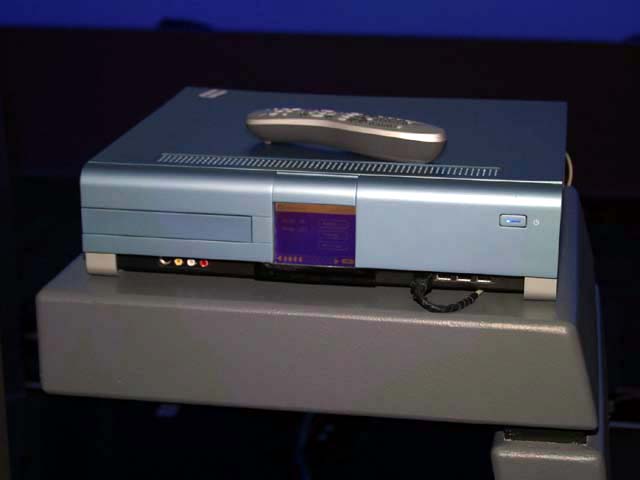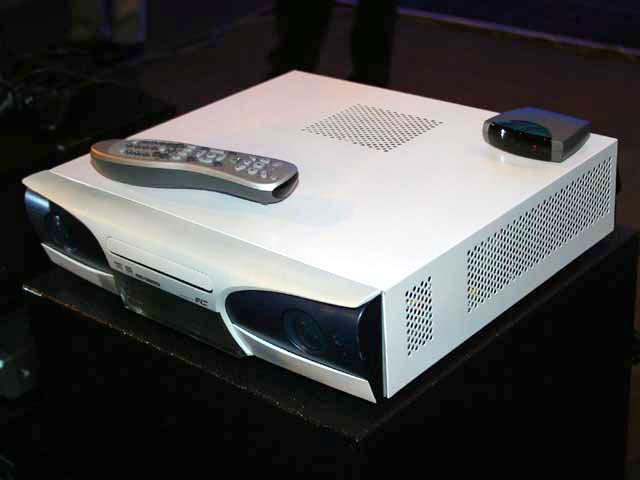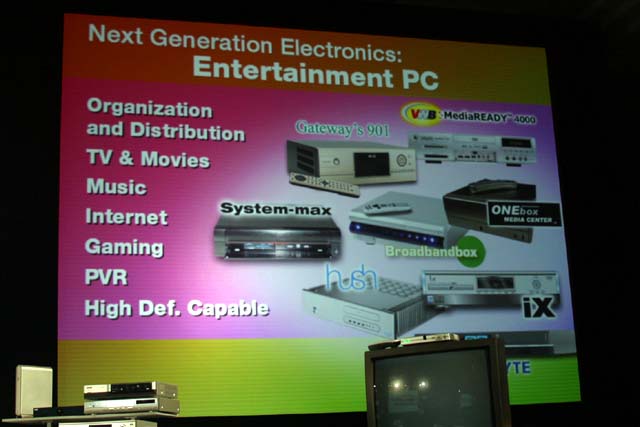MS dumps Intel, so Intel strikes back with its own Xbox-alike??? This is becoming interesting....Intel moots Centrino-style home PC platform
By Tony Smith
Posted: 17/02/2004 at 23:40 GMT
Intel wants its upcoming 'Grantsdale' chipset and the recently released 'Prescott' 90nm Pentium 4 to form the basis of a home computing platform along the lines of Centrino.
At this stage, it's not clear whether the chip giant intends to create a branded platform, as it did with Centrino, or simply tout the technology as a broad category of the home PC market.
Certainly it has been touting its Entertainment PC (EPC) categorisation rather a lot of late, but it also has a platform definition, codenamed 'Kessler', co-developed by FIC, that lays down what an EPC should contain: primarily a Prescott and Grantsdale, all inside a consumer electronics-style casing. The EPC is designed to work alongside consumer electronics devices such as big screen TVs and hi-fi speaker rigs, rather than sit in the corner next to a monitor.
Grantsdale will feature dual-channel 400/533MHz DDR 2 SDRAM support, PCI Express, the next generation of Intel's Extreme Graphics and 'Azalia', the high-end audio sub-system Intel announced last September as a component of 'Sonoma', aka Centrino 2.
Azalia is now officially called Intel High Definition Audio, and will offer Dolby 7.1 surround sound. Indeed, Dolby is producing a whole series of audio codecs that sit on top of HD Audio.
What will probably be called Extreme Graphics 3 will feature dual independent display support and deliver better graphics than "any of the game boxes on the market today", claimed Louis Burns, Intel VP and head of the company's desktop products group, during his IDF keynote today. It will support DirectX 9.
Grantsdale will also feature a software-based Wi-Fi access point to allow it to operate directly with any other 802.11-enabled system. While Grantsdale doesn't itself include a Wi-Fi adaptor, Intel will almost certainly include such a product should it define a Centrino-style platform. As Burns put it, "wireless is so fundamental to this usage model".
Grantsdale is due next quarter, according to Burns, most likely late March/early April, we reckon, when Intel will christen it the i915.
The Grantsdale-based EPC, meanwhile, is intended primarily as a media consumption system, said Burns. As Intel defines the category, the EPC will offer DVD and HDTV playback, a TV tuner, PVR functionality, consumer electronics-quality audio - ie. Azalia - and advanced 3D graphics for gaming (courtesy of Extreme Graphics 3).
Other home PC categories the company is pushing - all based on Grantsdale and Prescott - include the content making Creativity PC and the content consuming (but still recognisable as a desktop, unlike the EPC) Space-constrained PC.
Of course, to make a success of the EPC concept and the Kessler platform, Intel will need to improve Prescott's power characteristics - CE devices do not, as a whole, run as hot (or as noisily) as a desktop PC.
It also needs to ensure DDR 2 prices come down to DDR 2 levels. While DDR 2 volumes are expected to ramp considerably during Q3, prices aren't expected to come down to the a mainstream point until 2005. Interestingly, that's when Intel expects its 'Sandow' EPC reference design to be practical. By then it may also have lowered Prescott's power demands. ®
You are using an out of date browser. It may not display this or other websites correctly.
You should upgrade or use an alternative browser.
You should upgrade or use an alternative browser.
Intel building its own "XBox" sequel???
- Thread starter Deadmeat
- Start date
PC games, I would think. This isn't a console concept, but a small form-factor-like PC setup that is intended to run XP Media Center Edition.
And I do not hold high hopes for "Extreme" Graphics 3, even a GFFX 5200U is faster/better than today's gaming consoles, but that still makes it almost completely useless as a DX9 gaming card. To get good DX9 performance you need to throw tons of trannies at the problem, and if it's one thing integrated graphics are famous for, it's NOT spending much on that.
If Intel spent nearly as much on pipeline design and layout on IG3 as they do on their CPUs, they could make a tiny 1 or 2 pipe deferred rendering device that runs at 1-2GHz and gets decent gaming performance, but the chances of that happening I see as almost nil. Likely, we'll get an underwhelming 1 or 2 pipe immediate mode renderer that runs at around 300MHz instead and while performing better than current consoles, still totally lacks the oomph neccessary to handle tomorrow's games at anything but the lowest of resolutions, especially considering the shared framebuffer memory it'd use.
The audio side of the chipset seems interesting though, remains to see how much of it runs in software on the host CPU. Considering it'll be a pretty hefty chip driving this thing, I'd expect it to do most of the sound, but also vertex processing for 3D rendering for example.
I don't think Intel really wants to get into the console biz, more likely they're targetting Joe Average that isn't much interested in a regular PC, but instead wants to watch movies and play MP3s, and likely do some Tivo-style harddrive recording. Preferably, it should also look nice, maybe like a hifi component and go into the entertainment center stack along with other audio/video equipment.
This thing won't have the specs neccessary to take on upcoming consoles, but that won't be its main goal anyway. If the user wants to play games it's supposed to be capable of playing games, but it won't be uber at it. It'll be a nifty jack-of-all-trades, and probably pretty good at it too if one doesn't expect too much. Intel usually makes pretty decent stuff (except fast integrated graphics *cough*).
And I do not hold high hopes for "Extreme" Graphics 3, even a GFFX 5200U is faster/better than today's gaming consoles, but that still makes it almost completely useless as a DX9 gaming card. To get good DX9 performance you need to throw tons of trannies at the problem, and if it's one thing integrated graphics are famous for, it's NOT spending much on that.
If Intel spent nearly as much on pipeline design and layout on IG3 as they do on their CPUs, they could make a tiny 1 or 2 pipe deferred rendering device that runs at 1-2GHz and gets decent gaming performance, but the chances of that happening I see as almost nil. Likely, we'll get an underwhelming 1 or 2 pipe immediate mode renderer that runs at around 300MHz instead and while performing better than current consoles, still totally lacks the oomph neccessary to handle tomorrow's games at anything but the lowest of resolutions, especially considering the shared framebuffer memory it'd use.
The audio side of the chipset seems interesting though, remains to see how much of it runs in software on the host CPU. Considering it'll be a pretty hefty chip driving this thing, I'd expect it to do most of the sound, but also vertex processing for 3D rendering for example.
I don't think Intel really wants to get into the console biz, more likely they're targetting Joe Average that isn't much interested in a regular PC, but instead wants to watch movies and play MP3s, and likely do some Tivo-style harddrive recording. Preferably, it should also look nice, maybe like a hifi component and go into the entertainment center stack along with other audio/video equipment.
This thing won't have the specs neccessary to take on upcoming consoles, but that won't be its main goal anyway. If the user wants to play games it's supposed to be capable of playing games, but it won't be uber at it. It'll be a nifty jack-of-all-trades, and probably pretty good at it too if one doesn't expect too much. Intel usually makes pretty decent stuff (except fast integrated graphics *cough*).
MS dumps Intel, so Intel strikes back with its own Xbox-alike??? This is becoming interesting....
ya looks like a direct competitor to ps2/xbox to me.
AlphaWolf said:MS dumps Intel, so Intel strikes back with its own Xbox-alike??? This is becoming interesting....
ya looks like a direct competitor to ps2/xbox to me.

LOL
Intel doesn't have a great record with graphic, parallelism and new architectures.
A zillions-stage cpu with extremely limited execution units, 3 registers with weird instructions in an incredibly hand fine-tuned multi-gigahertz architecture is great for desktop computers. But for something like a console... They certainly have the ressources and the brains power, but is there some inspiration somewhere ?
Don't get me wrong, I love Intel, always have, gotta like programming those x86 bitches, which offer you a mixture of bad, great and evil designs. But I think Intel only got inspiration when they designed the 386 and then lost it
Still, the competition may awaken them.
A zillions-stage cpu with extremely limited execution units, 3 registers with weird instructions in an incredibly hand fine-tuned multi-gigahertz architecture is great for desktop computers. But for something like a console... They certainly have the ressources and the brains power, but is there some inspiration somewhere ?
Don't get me wrong, I love Intel, always have, gotta like programming those x86 bitches, which offer you a mixture of bad, great and evil designs. But I think Intel only got inspiration when they designed the 386 and then lost it
Still, the competition may awaken them.
Maybe they want something to look really good on their 50" LCOS TV's? 
nondescript
Regular
VIA, now Intel?!
Sweet, bring it on - the more the merrier.
Sweet, bring it on - the more the merrier.
Guden Oden said:To get good DX9 performance you need to throw tons of trannies at the problem,

SMarth,
How can you SAY that about the 386, it didn't even have any caches, whereas Moto's 020 already had that... Anyway, the evil of x86 must surely be hidden pretty well these days with the very VERY mature high-level language compilers we have these days.
Besides, apart from heat emissions and power draw, Prescott would be one helluva central processor for a console I'm sure. Still, that's a moot point now, MS surprised me completely when they went the PowerPC (or so I assume) route instead. Maybe they got a better deal from IBM, or maybe the high power and heat of the P4 just killed Intel from the start; G5 @ 2.5GHz is said to be around 25W and something like half the die size of Prescott if I'm not mistaken. Now, a Prescott at 3.4GHz is likely faster, at least in most cases, but with 4x power draw and a large difference in physical size the performance difference in Intel's favor probably isn't worth it, at least not in a consumer device...
How can you SAY that about the 386, it didn't even have any caches, whereas Moto's 020 already had that... Anyway, the evil of x86 must surely be hidden pretty well these days with the very VERY mature high-level language compilers we have these days.
Besides, apart from heat emissions and power draw, Prescott would be one helluva central processor for a console I'm sure. Still, that's a moot point now, MS surprised me completely when they went the PowerPC (or so I assume) route instead. Maybe they got a better deal from IBM, or maybe the high power and heat of the P4 just killed Intel from the start; G5 @ 2.5GHz is said to be around 25W and something like half the die size of Prescott if I'm not mistaken. Now, a Prescott at 3.4GHz is likely faster, at least in most cases, but with 4x power draw and a large difference in physical size the performance difference in Intel's favor probably isn't worth it, at least not in a consumer device...
Well they could liscense the series 5 chip and uses that as the new extreme graphics . They already have the mbx liscense .
If its cheap , small and plays pc games alone with mabye dvd movies and music then i see no problem with it being sold and it might even cut into some of the xbox 2/ ps3 sales .
If its cheap , small and plays pc games alone with mabye dvd movies and music then i see no problem with it being sold and it might even cut into some of the xbox 2/ ps3 sales .
jvd said:Well they could liscense the series 5 chip and uses that as the new extreme graphics . They already have the mbx liscense .
If its cheap , small and plays pc games alone with mabye dvd movies and music then i see no problem with it being sold and it might even cut into some of the xbox 2/ ps3 sales .
If anything, it would cut into some of the PC sales...
jvd said:Well they could liscense the series 5 chip and uses that as the new extreme graphics .
If that was the case, I'm sure there would have been press releases issued about it. Also, if PVR series 5 appears as Intel's EG3, that seriously diminishes my hopes of a line of discrete series 5 graphics cards, one of which could find a home in my AGP slot...
Guden Oden said:jvd said:Well they could liscense the series 5 chip and uses that as the new extreme graphics .
If that was the case, I'm sure there would have been press releases issued about it. Also, if PVR series 5 appears as Intel's EG3, that seriously diminishes my hopes of a line of discrete series 5 graphics cards, one of which could find a home in my AGP slot...
Well i know they have liscenses for mbx . I think i remember a liscense for series 3. Perhaps they already have one for series 5 . THey could have them and not plan on using them .
Anyway if anything having intel produce power vr graphics chips could only help powervr . Having a player who has what 30% of the market selling your chips intergrated is a good way to get app support. ALso a series 5 on a northbridge would be worlds faster than a nforce 2 video chip and most likely a 9700 moblie chip and cost less .
jvd said:I think i remember a liscense for series 3.
Series 3 was the Kyro line, which ST owned the license to. Series 4 wasn't licensed to anyone, and that seems to be true of series 5 as well. At least so far.
Having a player who has what 30% of the market selling your chips intergrated is a good way to get app support.
Intel's something like 45% or such, or almost anyway. ATi and NV are both very close to 25, and Intel has almost everything of the remainder of the market. Still, it sounds too good to be true, and I don't think Intel wants to license someone else's tech either, they probably reason they can make more money doing the R&D themselves...
Anyway, as long as series 5 support the major APIs, they don't really NEED app support; that would come automatically by itself since apps support those APIs...
Megadrive1988
Veteran
I will laugh my ass off if Intel attempts to produce its own entertainment platform.
One would think they'd interfere with the DISCover consoles or whatever form of the Phantom comes out if they ever make it to market, but I don't really see and of the PC-gaming consoles interfering with consoles as we know them--there are too many differences in the development markets and many "problems" with PC gamng that will still persist even on small, dedicated machines that makes people prefer consoles to begin with.
With luck, though, popularity of such machines (if they acheive a decent amount) will increase the amount of porting and the types of games ported from one to another (the majority I would imagine being from console to PC), giving owners of either a wider selection.
With luck, though, popularity of such machines (if they acheive a decent amount) will increase the amount of porting and the types of games ported from one to another (the majority I would imagine being from console to PC), giving owners of either a wider selection.
Similar threads
- Replies
- 41
- Views
- 3K
- Locked
- Replies
- 260
- Views
- 16K
- Replies
- 9
- Views
- 659
- Replies
- 1K
- Views
- 87K




